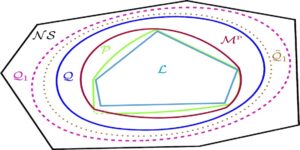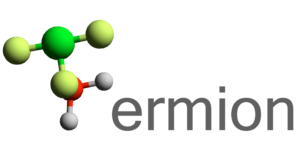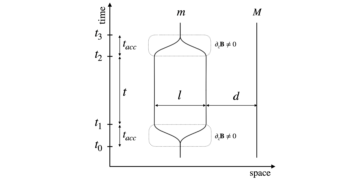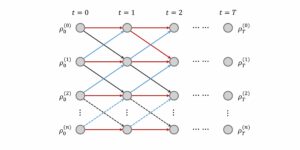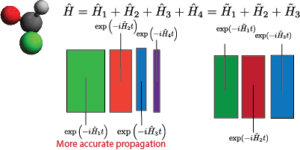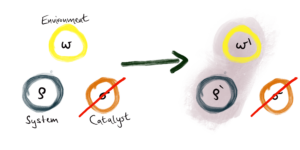1School of Physics, University of Melbourne, Parkville, VIC 3010, Australia
2School of Mathematics and Statistics, University of Melbourne, Parkville, VIC 3010, Australia
اس کاغذ کو دلچسپ لگتا ہے یا اس پر بات کرنا چاہتے ہیں؟ SciRate پر تبصرہ کریں یا چھوڑیں۔.
خلاصہ
In the lead up to fault tolerance, the utility of quantum computing will be determined by how adequately the effects of noise can be circumvented in quantum algorithms. Hybrid quantum-classical algorithms such as the variational quantum eigensolver (VQE) have been designed for the short-term regime. However, as problems scale, VQE results are generally scrambled by noise on present-day hardware. While error mitigation techniques alleviate these issues to some extent, there is a pressing need to develop algorithmic approaches with higher robustness to noise. Here, we explore the robustness properties of the recently introduced quantum computed moments (QCM) approach to ground state energy problems, and show through an analytic example how the underlying energy estimate explicitly filters out incoherent noise. Motivated by this observation, we implement QCM for a model of quantum magnetism on IBM Quantum hardware to examine the noise-filtering effect with increasing circuit depth. We find that QCM maintains a remarkably high degree of error robustness where VQE completely fails. On instances of the quantum magnetism model up to 20 qubits for ultra-deep trial state circuits of up to 500 CNOTs, QCM is still able to extract reasonable energy estimates. The observation is bolstered by an extensive set of experimental results. To match these results, VQE would need hardware improvement by some 2 orders of magnitude on error rates.
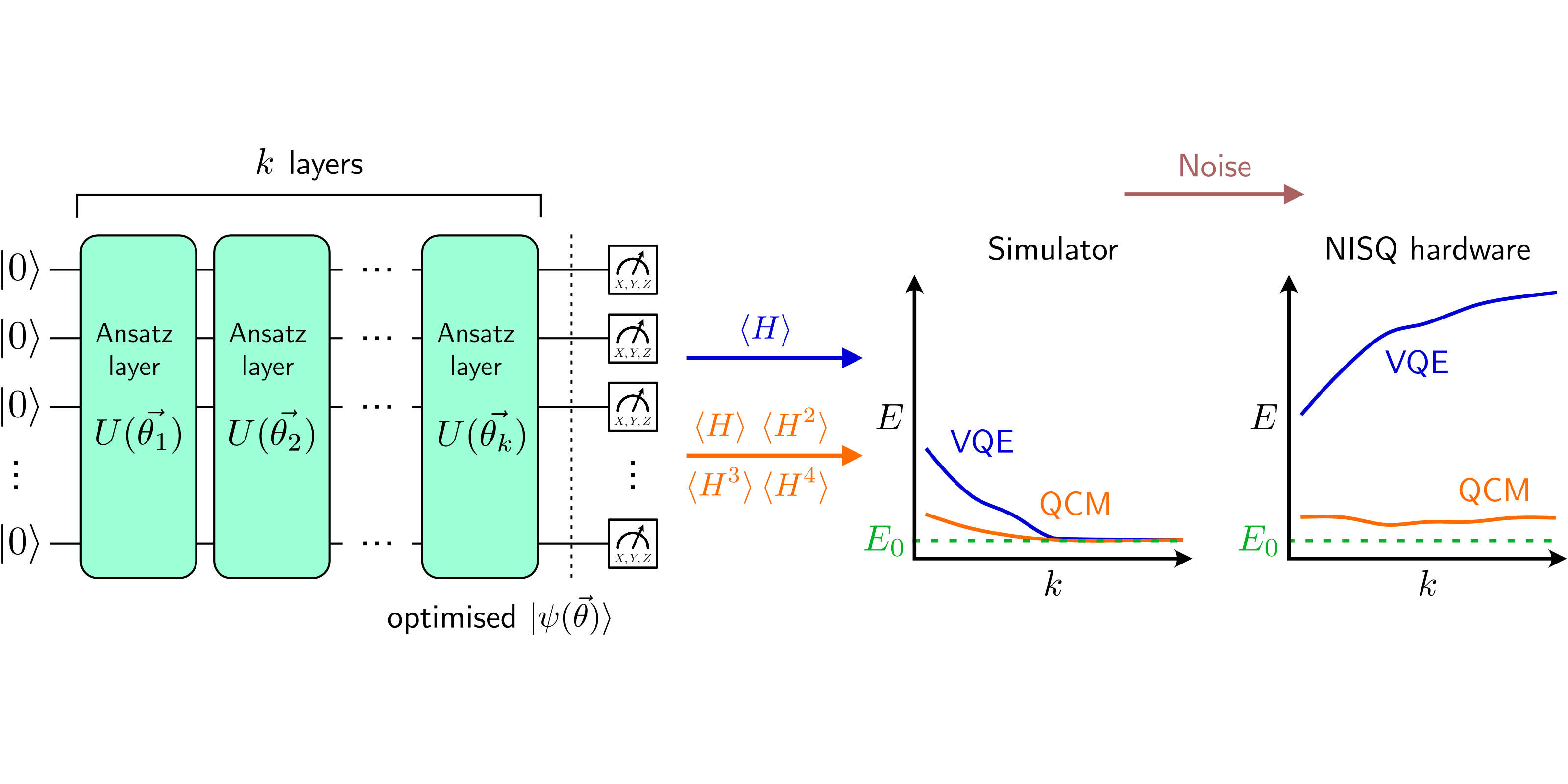
مقبول خلاصہ
Our results show that the remarkable filtering effect of the moments-based technique appears to circumvent the effects of noise at the core of present day quantum computing, and point the way to potentially achieving practical quantum advantage on hardware in the near-term.
► BibTeX ڈیٹا
► حوالہ جات
ہے [1] Sepehr Ebadi, Tout T Wang, Harry Levine, Alexander Keesling, Giulia Semeghini, Ahmed Omran, Dolev Bluvstein, Rhine Samajdar, Hannes Pichler, Wen Wei Ho, et al. “Quantum phases of matter on a 256-atom programmable quantum simulator”. Nature 595, 227–232 (2021). url: https://doi.org/10.1038/s41586-021-03582-4.
https://doi.org/10.1038/s41586-021-03582-4
ہے [2] Xiao Mi, Pedram Roushan, Chris Quintana, Salvatore Mandra, Jeffrey Marshall, Charles Neill, Frank Arute, Kunal Arya, Juan Atalaya, Ryan Babbush, et al. “Information scrambling in quantum circuits”. Science 374, 1479–1483 (2021). url: https://doi.org/10.1126/science.abg5029.
https://doi.org/10.1126/science.abg5029
ہے [3] Gary J Mooney, Gregory AL White, Charles D Hill, and Lloyd CL Hollenberg. “Whole-Device Entanglement in a 65-Qubit Superconducting Quantum Computer”. Advanced Quantum Technologies 4, 2100061 (2021). url: https://doi.org/10.1002/qute.202100061.
https://doi.org/10.1002/qute.202100061
ہے [4] Philipp Frey and Stephan Rachel. “Realization of a discrete time crystal on 57 qubits of a quantum computer”. Science Advances 8, eabm7652 (2022). url: https://doi.org/10.1126/sciadv.abm7652.
https://doi.org/10.1126/sciadv.abm7652
ہے [5] Ashley Montanaro. “Quantum algorithms: an overview”. npj Quantum Information 2, 1–8 (2016). url: https://doi.org/10.1038/npjqi.2015.23.
https://doi.org/10.1038/npjqi.2015.23
ہے [6] Peter W Shor. “Algorithms for quantum computation: discrete logarithms and factoring”. In Proceedings 35th annual symposium on foundations of computer science. Pages 124–134. IEEE (1994). url: https://doi.org/10.1109/SFCS.1994.365700.
https:///doi.org/10.1109/SFCS.1994.365700
ہے [7] Craig Gidney and Martin Ekerå. “How to factor 2048 bit RSA integers in 8 hours using 20 million noisy qubits”. Quantum 5, 433 (2021). url: https://doi.org/10.22331/q-2021-04-15-433.
https://doi.org/10.22331/q-2021-04-15-433
ہے [8] Alán Aspuru-Guzik, Anthony D Dutoi, Peter J Love, and Martin Head-Gordon. “Simulated quantum computation of molecular energies”. Science 309, 1704–1707 (2005). url: https://doi.org/10.1126/science.1113479.
https://doi.org/10.1126/science.1113479
ہے [9] John Preskill. “Quantum computing in the NISQ era and beyond”. Quantum 2, 79 (2018). url: https://doi.org/10.22331/q-2018-08-06-79.
https://doi.org/10.22331/q-2018-08-06-79
ہے [10] Jay Gambetta. “IBM’s roadmap for scaling quantum technology” (2020).
ہے [11] M Morgado and S Whitlock. “Quantum simulation and computing with Rydberg-interacting qubits”. AVS Quantum Science 3, 023501 (2021). url: https://doi.org/10.1116/5.0036562.
https://doi.org/10.1116/5.0036562
ہے [12] Frank Arute, Kunal Arya, Ryan Babbush, Dave Bacon, Joseph C Bardin, Rami Barends, Rupak Biswas, Sergio Boixo, Fernando GSL Brandao, David A Buell, et al. “Quantum supremacy using a programmable superconducting processor”. Nature 574, 505–510 (2019). url: https://doi.org/10.1038/s41586-019-1666-5.
https://doi.org/10.1038/s41586-019-1666-5
ہے [13] Han-Sen Zhong, Hui Wang, Yu-Hao Deng, Ming-Cheng Chen, Li-Chao Peng, Yi-Han Luo, Jian Qin, Dian Wu, Xing Ding, Yi Hu, et al. “Quantum computational advantage using photons”. Science 370, 1460–1463 (2020). url: https://doi.org/10.1126/science.abe8770.
https://doi.org/10.1126/science.abe8770
ہے [14] Andrew J Daley, Immanuel Bloch, Christian Kokail, Stuart Flannigan, Natalie Pearson, Matthias Troyer, and Peter Zoller. “Practical quantum advantage in quantum simulation”. Nature 607, 667–676 (2022). url: https://doi.org/10.1038/s41586-022-04940-6.
https://doi.org/10.1038/s41586-022-04940-6
ہے [15] Iulia M Georgescu, Sahel Ashhab, and Franco Nori. “Quantum simulation”. Reviews of Modern Physics 86, 153 (2014). url: https://doi.org/10.1103/RevModPhys.86.153.
https:///doi.org/10.1103/RevModPhys.86.153
ہے [16] Abhinav Kandala, Antonio Mezzacapo, Kristan Temme, Maika Takita, Markus Brink, Jerry M Chow, and Jay M Gambetta. “Hardware-efficient variational quantum eigensolver for small molecules and quantum magnets”. Nature 549, 242–246 (2017). url: https://doi.org/10.1038/nature23879.
https://doi.org/10.1038/nature23879
ہے [17] Yudong Cao, Jonathan Romero, Jonathan P Olson, Matthias Degroote, Peter D Johnson, Mária Kieferová, Ian D Kivlichan, Tim Menke, Borja Peropadre, Nicolas PD Sawaya, et al. “Quantum chemistry in the age of quantum computing”. Chemical reviews 119, 10856–10915 (2019). url: https://doi.org/10.1021/acs.chemrev.8b00803.
https:///doi.org/10.1021/acs.chemrev.8b00803
ہے [18] Alberto Peruzzo, Jarrod McClean, Peter Shadbolt, Man-Hong Yung, Xiao-Qi Zhou, Peter J Love, Alán Aspuru-Guzik, and Jeremy L O’brien. “A variational eigenvalue solver on a photonic quantum processor”. Nature communications 5, 1–7 (2014). url: https://doi.org/10.1038/ncomms5213.
https://doi.org/10.1038/ncomms5213
ہے [19] Dmitry A Fedorov, Bo Peng, Niranjan Govind, and Yuri Alexeev. “VQE method: A short survey and recent developments”. Materials Theory 6, 1–21 (2022). url: https://doi.org/10.1186/s41313-021-00032-6.
https://doi.org/10.1186/s41313-021-00032-6
ہے [20] Harper R Grimsley, Sophia E Economou, Edwin Barnes, and Nicholas J Mayhall. “An adaptive variational algorithm for exact molecular simulations on a quantum computer”. Nature communications 10, 1–9 (2019). url: https://doi.org/10.1038/s41467-019-10988-2.
https://doi.org/10.1038/s41467-019-10988-2
ہے [21] Ho Lun Tang, VO Shkolnikov, George S Barron, Harper R Grimsley, Nicholas J Mayhall, Edwin Barnes, and Sophia E Economou. “qubit-adapt-vqe: An adaptive algorithm for constructing hardware-efficient ansätze on a quantum processor”. PRX Quantum 2, 020310 (2021). url: https://doi.org/10.1103/PRXQuantum.2.020310.
https:///doi.org/10.1103/PRXQuantum.2.020310
ہے [22] Bryan T Gard, Linghua Zhu, George S Barron, Nicholas J Mayhall, Sophia E Economou, and Edwin Barnes. “Efficient symmetry-preserving state preparation circuits for the variational quantum eigensolver algorithm”. npj Quantum Information 6, 1–9 (2020). url: https://doi.org/10.1038/s41534-019-0240-1.
https://doi.org/10.1038/s41534-019-0240-1
ہے [23] Kazuhiro Seki, Tomonori Shirakawa, and Seiji Yunoki. “Symmetry-adapted variational quantum eigensolver”. Physical Review A 101, 052340 (2020). url: https://doi.org/10.1103/PhysRevA.101.052340.
https:///doi.org/10.1103/PhysRevA.101.052340
ہے [24] Gian-Luca R Anselmetti, David Wierichs, Christian Gogolin, and Robert M Parrish. “Local, expressive, quantum-number-preserving VQE ansätze for fermionic systems”. New Journal of Physics 23, 113010 (2021). url: https://doi.org/10.1088/1367-2630/ac2cb3.
https://doi.org/10.1088/1367-2630/ac2cb3
ہے [25] Raffaele Santagati, Jianwei Wang, Antonio A Gentile, Stefano Paesani, Nathan Wiebe, Jarrod R McClean, Sam Morley-Short, Peter J Shadbolt, Damien Bonneau, Joshua W Silverstone, et al. “Witnessing eigenstates for quantum simulation of Hamiltonian spectra”. Science Advances 4, eaap9646 (2018). url: https://doi.org/10.1126/sciadv.aap9646.
https://doi.org/10.1126/sciadv.aap9646
ہے [26] Ikko Hamamura and Takashi Imamichi. “Efficient evaluation of quantum observables using entangled measurements”. npj Quantum Information 6, 1–8 (2020). url: https://doi.org/10.1038/s41534-020-0284-2.
https://doi.org/10.1038/s41534-020-0284-2
ہے [27] Hsin-Yuan Huang, Richard Kueng, and John Preskill. “Efficient estimation of Pauli observables by derandomization”. Physical Review Letters 127, 030503 (2021). url: https://doi.org/10.1103/PhysRevLett.127.030503.
https:///doi.org/10.1103/PhysRevLett.127.030503
ہے [28] Junyu Liu, Frederik Wilde, Antonio Anna Mele, Liang Jiang, and Jens Eisert. “Noise can be helpful for variational quantum algorithms” (2022). url: https://doi.org/10.48550/arXiv.2210.06723.
https://doi.org/10.48550/arXiv.2210.06723
ہے [29] Samson Wang, Enrico Fontana, Marco Cerezo, Kunal Sharma, Akira Sone, Lukasz Cincio, and Patrick J Coles. “Noise-induced barren plateaus in variational quantum algorithms”. Nature communications 12, 1–11 (2021). url: https://doi.org/10.1038/s41467-021-27045-6.
https://doi.org/10.1038/s41467-021-27045-6
ہے [30] Enrico Fontana, Nathan Fitzpatrick, David Muñoz Ramo, Ross Duncan, and Ivan Rungger. “Evaluating the noise resilience of variational quantum algorithms”. Physical Review A 104, 022403 (2021). url: https://doi.org/10.1103/PhysRevA.104.022403.
https:///doi.org/10.1103/PhysRevA.104.022403
ہے [31] Sebastian Brandhofer, Simon Devitt, and Ilia Polian. “Error Analysis of the Variational Quantum Eigensolver Algorithm”. In 2021 IEEE/ACM International Symposium on Nanoscale Architectures (NANOARCH). Pages 1–6. IEEE (2021). url: https://doi.org/10.1109/NANOARCH53687.2021.9642249.
https://doi.org/10.1109/NANOARCH53687.2021.9642249
ہے [32] Peter J J O’Malley, Ryan Babbush, Ian D Kivlichan, Jonathan Romero, Jarrod R McClean, Rami Barends, Julian Kelly, Pedram Roushan, Andrew Tranter, Nan Ding, et al. “Scalable quantum simulation of molecular energies”. Physical Review X 6, 031007 (2016). url: https://doi.org/10.1103/PhysRevX.6.031007.
https:///doi.org/10.1103/PhysRevX.6.031007
ہے [33] Yangchao Shen, Xiang Zhang, Shuaining Zhang, Jing-Ning Zhang, Man-Hong Yung, and Kihwan Kim. “Quantum implementation of the unitary coupled cluster for simulating molecular electronic structure”. Physical Review A 95, 020501 (2017). url: https://doi.org/10.1103/PhysRevA.95.020501.
https:///doi.org/10.1103/PhysRevA.95.020501
ہے [34] Frank Arute, Kunal Arya, Ryan Babbush, Dave Bacon, Joseph C Bardin, Rami Barends, Sergio Boixo, Michael Broughton, Bob B Buckley, et al. “Hartree-Fock on a superconducting qubit quantum computer”. Science 369, 1084–1089 (2020). url: https://doi.org/10.1126/science.abb9811.
https:///doi.org/10.1126/science.abb9811
ہے [35] Seunghoon Lee, Joonho Lee, Huanchen Zhai, Yu Tong, Alexander M Dalzell, Ashutosh Kumar, Phillip Helms, Johnnie Gray, Zhi-Hao Cui, Wenyuan Liu, et al. “Is there evidence for exponential quantum advantage in quantum chemistry?” (2022). url: https://doi.org/10.48550/arXiv.2208.02199.
https://doi.org/10.48550/arXiv.2208.02199
ہے [36] Harish J Vallury, Michael A Jones, Charles D Hill, and Lloyd C L Hollenberg. “Quantum computed moments correction to variational estimates”. Quantum 4, 373 (2020). url: https://doi.org/10.22331/q-2020-12-15-373.
https://doi.org/10.22331/q-2020-12-15-373
ہے [37] Lloyd C L Hollenberg. “Plaquette expansion in lattice Hamiltonian models”. Physical Review D 47, 1640 (1993). url: https://doi.org/10.1103/PhysRevD.47.1640.
https:///doi.org/10.1103/PhysRevD.47.1640
ہے [38] Lloyd C L Hollenberg and NS Witte. “General nonperturbative estimate of the energy density of lattice Hamiltonians”. Physical Review D 50, 3382 (1994). url: https://doi.org/10.1103/PhysRevD.50.3382.
https:///doi.org/10.1103/PhysRevD.50.3382
ہے [39] Lloyd C L Hollenberg and NS Witte. “Analytic solution for the ground-state energy of the extensive many-body problem”. Physical Review B 54, 16309 (1996). url: https://doi.org/10.1103/PhysRevB.54.16309.
https:///doi.org/10.1103/PhysRevB.54.16309
ہے [40] Michael A Jones, Harish J Vallury, Charles D Hill, and Lloyd C L Hollenberg. “Chemistry beyond the Hartree–Fock energy via quantum computed moments”. Scientific Reports 12, 1–9 (2022). url: https://doi.org/10.1038/s41598-022-12324-z.
https://doi.org/10.1038/s41598-022-12324-z
ہے [41] ایڈورڈ فرہی، جیفری گولڈ اسٹون، اور سیم گٹ مین۔ "ایک کوانٹم تخمینی اصلاح الگورتھم" (2014)۔ url: https://doi.org/10.48550/arXiv.1411.4028۔
https://doi.org/10.48550/arXiv.1411.4028
ہے [42] Aochen Duan. “Matrix product states in quantum information processing”. Master’s thesis. School of Physics, The University of Melbourne. (2015).
ہے [43] Michael A. Jones. “Moments-based corrections to variational quantum computation”. Master’s thesis. School of Physics, The University of Melbourne. (2019).
ہے [44] Karol Kowalski and Bo Peng. “Quantum simulations employing connected moments expansions”. The Journal of Chemical Physics 153, 201102 (2020). url: https://doi.org/10.1063/5.0030688.
https://doi.org/10.1063/5.0030688
ہے [45] Kazuhiro Seki and Seiji Yunoki. “Quantum power method by a superposition of time-evolved states”. PRX Quantum 2, 010333 (2021). url: https://doi.org/10.1103/PRXQuantum.2.010333.
https:///doi.org/10.1103/PRXQuantum.2.010333
ہے [46] Philippe Suchsland, Francesco Tacchino, Mark H Fischer, Titus Neupert, Panagiotis Kl Barkoutsos, and Ivano Tavernelli. “Algorithmic error mitigation scheme for current quantum processors”. Quantum 5, 492 (2021). url: https://doi.org/10.22331/q-2021-07-01-492.
https://doi.org/10.22331/q-2021-07-01-492
ہے [47] Joseph C Aulicino, Trevor Keen, and Bo Peng. “State preparation and evolution in quantum computing: A perspective from Hamiltonian moments”. International Journal of Quantum Chemistry 122, e26853 (2022). url: https://doi.org/10.1002/qua.26853.
https://doi.org/10.1002/qua.26853
ہے [48] Lloyd C L Hollenberg, David C Bardos, and NS Witte. “Lanczos cluster expansion for non-extensive systems”. Zeitschrift für Physik D Atoms, Molecules and Clusters 38, 249–252 (1996). url: https://doi.org/10.1007/s004600050089.
https://doi.org/10.1007/s004600050089
ہے [49] David Horn and Marvin Weinstein. “The t expansion: A nonperturbative analytic tool for Hamiltonian systems”. Physical Review D 30, 1256 (1984). url: https://doi.org/10.1103/PhysRevD.30.1256.
https:///doi.org/10.1103/PhysRevD.30.1256
ہے [50] Calvin Stubbins. “Methods of extrapolating the t-expansion series”. Physical Review D 38, 1942 (1988). url: https://doi.org/10.1103/PhysRevD.38.1942.
https:///doi.org/10.1103/PhysRevD.38.1942
ہے [51] J Cioslowski. “Connected moments expansion: a new tool for quantum many-body theory”. Physical review letters 58, 83 (1987). url: https://doi.org/10.1103/PhysRevLett.58.83.
https:///doi.org/10.1103/PhysRevLett.58.83
ہے [52] Alexander M Dalzell, Nicholas Hunter-Jones, and Fernando GSL Brandão. “Random quantum circuits transform local noise into global white noise” (2021). url: https://doi.org/10.48550/arXiv.2111.14907.
https://doi.org/10.48550/arXiv.2111.14907
ہے [53] NS Witte and Lloyd C L Hollenberg. “Accurate calculation of ground-state energies in an analytic Lanczos expansion”. Journal of Physics: Condensed Matter 9, 2031 (1997). url: https://doi.org/10.1088/0953-8984/9/9/016.
https://doi.org/10.1088/0953-8984/9/9/016
ہے [54] Qiskit تعاون کنندگان۔ "کیسکیٹ: کوانٹم کمپیوٹنگ کے لیے ایک اوپن سورس فریم ورک" (2023)۔
ہے [55] Suguru Endo, Simon C Benjamin, and Ying Li. “Practical quantum error mitigation for near-future applications”. Physical Review X 8, 031027 (2018). url: https://doi.org/10.1103/PhysRevX.8.031027.
https:///doi.org/10.1103/PhysRevX.8.031027
ہے [56] Tudor Giurgica-Tiron, Yousef Hindy, Ryan LaRose, Andrea Mari, and William J Zeng. “Digital zero noise extrapolation for quantum error mitigation”. In 2020 IEEE International Conference on Quantum Computing and Engineering (QCE). Pages 306–316. IEEE (2020). url: https://doi.org/10.1109/QCE49297.2020.00045.
https://doi.org/10.1109/QCE49297.2020.00045
ہے [57] Kristan Temme, Sergey Bravyi, and Jay M Gambetta. “Error mitigation for short-depth quantum circuits”. Physical review letters 119, 180509 (2017). url: https://doi.org/10.1103/PhysRevLett.119.180509.
https:///doi.org/10.1103/PhysRevLett.119.180509
ہے [58] Sergey Bravyi, Sarah Sheldon, Abhinav Kandala, David C Mckay, and Jay M Gambetta. “Mitigating measurement errors in multiqubit experiments”. Physical Review A 103, 042605 (2021). url: https://doi.org/10.1103/PhysRevA.103.042605.
https:///doi.org/10.1103/PhysRevA.103.042605
ہے [59] Hendrik Weimer, Augustine Kshetrimayum, and Román Orús. “Simulation methods for open quantum many-body systems”. Reviews of Modern Physics 93, 015008 (2021). url: https://doi.org/10.1103/RevModPhys.93.015008.
https:///doi.org/10.1103/RevModPhys.93.015008
ہے [60] Pranav Gokhale, Olivia Angiuli, Yongshan Ding, Kaiwen Gui, Teague Tomesh, Martin Suchara, Margaret Martonosi, and Frederic T Chong. “$ O (N^{3}) $ Measurement Cost for Variational Quantum Eigensolver on Molecular Hamiltonians”. IEEE Transactions on Quantum Engineering 1, 1–24 (2020). url: https://doi.org/10.1109/TQE.2020.3035814.
https://doi.org/10.1109/TQE.2020.3035814
ہے [61] Lloyd C L Hollenberg and Michael J Tomlinson. “Staggered magnetisation in the Heisenberg antiferromagnet”. Australian journal of physics 47, 137–144 (1994). url: https://doi.org/10.1071/PH940137.
https://doi.org/10.1071/PH940137
کی طرف سے حوالہ دیا گیا
[1] Floyd M. Creevey, Charles D. Hill, and Lloyd C. L. Hollenberg, “GASP: a genetic algorithm for state preparation on quantum computers”, سائنسی رپورٹس 13، 11956 (2023).
مذکورہ بالا اقتباسات سے ہیں۔ SAO/NASA ADS (آخری بار کامیابی کے ساتھ 2023-09-11 15:35:44)۔ فہرست نامکمل ہو سکتی ہے کیونکہ تمام ناشرین مناسب اور مکمل حوالہ ڈیٹا فراہم نہیں کرتے ہیں۔
نہیں لا سکا کراس ریف کا حوالہ دیا گیا ڈیٹا آخری کوشش کے دوران 2023-09-11 15:35:43: Crossref سے 10.22331/q-2023-09-11-1109 کے لیے حوالہ کردہ ڈیٹا حاصل نہیں کیا جا سکا۔ یہ عام بات ہے اگر DOI حال ہی میں رجسٹر کیا گیا ہو۔
یہ مقالہ کوانٹم میں کے تحت شائع کیا گیا ہے۔ Creative Commons انتساب 4.0 انٹرنیشنل (CC BY 4.0) لائسنس کاپی رائٹ اصل کاپی رائٹ ہولڈرز جیسے مصنفین یا ان کے اداروں کے پاس رہتا ہے۔
- SEO سے چلنے والا مواد اور PR کی تقسیم۔ آج ہی بڑھا دیں۔
- پلیٹو ڈیٹا ڈاٹ نیٹ ورک ورٹیکل جنریٹو اے آئی۔ اپنے آپ کو بااختیار بنائیں۔ یہاں تک رسائی حاصل کریں۔
- پلیٹوآئ اسٹریم۔ ویب 3 انٹیلی جنس۔ علم میں اضافہ۔ یہاں تک رسائی حاصل کریں۔
- پلیٹو ای ایس جی۔ آٹوموٹو / ای وی، کاربن، کلین ٹیک، توانائی ، ماحولیات، شمسی، ویسٹ مینجمنٹ یہاں تک رسائی حاصل کریں۔
- پلیٹو ہیلتھ۔ بائیوٹیک اینڈ کلینیکل ٹرائلز انٹیلی جنس۔ یہاں تک رسائی حاصل کریں۔
- چارٹ پرائم۔ ChartPrime کے ساتھ اپنے ٹریڈنگ گیم کو بلند کریں۔ یہاں تک رسائی حاصل کریں۔
- بلاک آفسیٹس۔ ماحولیاتی آفسیٹ ملکیت کو جدید بنانا۔ یہاں تک رسائی حاصل کریں۔
- ماخذ: https://quantum-journal.org/papers/q-2023-09-11-1109/
- : ہے
- : نہیں
- :کہاں
- ][p
- $UP
- 1
- 10
- 11
- 12
- 13
- 14
- 15٪
- 16
- 17
- 19
- 1994
- 1996
- 20
- 2005
- 2014
- 2015
- 2016
- 2017
- 2018
- 2019
- 2020
- 2021
- 2022
- 2023
- 2031
- 22
- 23
- 24
- 25
- 26
- 27
- 28
- 29
- 30
- 31
- 32
- 33
- 36
- 39
- 40
- 41
- 46
- 49
- 50
- 500
- 51
- 52
- 53
- 54
- 60
- 7
- 8
- 9
- a
- قابلیت
- اوپر
- خلاصہ
- تک رسائی حاصل
- حصول
- انکولی
- ایڈیشنل
- مناسب
- اعلی درجے کی
- ترقی
- فائدہ
- وابستگیاں
- عمر
- احمد
- AL
- الیگزینڈر
- یلگورتم
- الگورتھم
- یلگوردمز
- تمام
- کم
- an
- تجزیہ
- تجزیہ
- تجزیاتی
- اور
- اینڈریو
- اننا
- سالانہ
- انتھونی
- ایپلی کیشنز
- نقطہ نظر
- نقطہ نظر
- تخمینہ
- کیا
- AS
- At
- آسٹریلیا
- مصنف
- مصنفین
- b
- بنجر
- BE
- رہا
- بنیامین
- سے پرے
- بٹ
- Bo
- باب
- توڑ
- برتن
- برائن
- لیکن
- by
- حساب سے
- کیلوئن
- کر سکتے ہیں
- چیلنج
- چارلس
- کیمیائی
- کیمسٹری
- چن
- چونگ
- چاؤ
- کرس
- کلسٹر
- تبصرہ
- کامن
- عمومی
- کموینیکیشن
- مکمل
- مکمل طور پر
- حساب
- کمپیوٹر
- کمپیوٹر سائنس
- کمپیوٹر
- کمپیوٹنگ
- گاڑھا مادہ
- کانفرنس
- منسلک
- تعمیر
- یوگدانکرتاوں
- روایتی
- کاپی رائٹ
- کور
- درست
- اصلاحات
- قیمت
- سکتا ہے
- مل کر
- کریگ
- کرسٹل
- موجودہ
- اعداد و شمار
- ڈیو
- ڈیوڈ
- دن
- گہری
- ڈگری
- یہ
- کثافت
- گہرائی
- ڈیزائن
- اس بات کا تعین
- کا تعین
- ترقی
- ترقی یافتہ
- رفت
- آلہ
- بات چیت
- خلل
- ڈنکن
- کے دوران
- e
- ای اینڈ ٹی
- ایڈورڈ
- ایڈون
- اثر
- اثرات
- یا تو
- الیکٹرانک
- توانائی
- توانائی کی کثافت
- انجنیئرنگ
- کافی
- دور
- خرابی
- نقائص
- تخمینہ
- اندازوں کے مطابق
- Ether (ETH)
- تشخیص
- بھی
- ثبوت
- ارتقاء
- جانچ پڑتال
- مثال کے طور پر
- وجود
- توسیع
- تجرباتی
- تجربات
- تلاش
- ظالمانہ
- اظہار
- وسیع
- حد تک
- نکالنے
- عنصر
- ناکام رہتا ہے
- میدان
- فلٹرنگ
- فلٹر
- مل
- Fitzpatrick
- فلائڈ
- کے لئے
- بنیادیں
- فریم ورک
- فرینک
- سے
- گیری
- گیٹس
- جنرل
- عام طور پر
- جارج
- گلوبل
- بھوری رنگ
- سب سے بڑا
- گراؤنڈ
- ہارڈ ویئر
- ہارورڈ
- ہے
- مدد گار
- یہاں
- ہائی
- اعلی
- ہولڈرز
- HOURS
- کس طرح
- تاہم
- HTTPS
- ہانگ
- ہائبرڈ
- ہائبرڈ کوانٹم کلاسیکل
- IBM
- ibm کوانٹم
- IEEE
- if
- پر عملدرآمد
- نفاذ
- بہتری
- in
- اضافہ
- اضافہ
- معلومات
- موروثی طور پر
- اداروں
- دلچسپ
- بین الاقوامی سطح پر
- میں
- متعارف
- شامل
- مسائل
- آئیون
- جاوا سکرپٹ
- جیفری
- جان
- جانی
- جانسن
- جوناتھن
- جونز
- اس وقت یہوشو
- جرنل
- جان
- Keen
- کم
- کمر
- آخری
- قیادت
- چھوڑ دو
- لی
- سطح
- li
- لائسنس
- لسٹ
- مقامی
- محبت
- مقناطیسیت
- میگنےٹ
- برقرار رکھتا ہے
- مارکو
- نشان
- مارٹن
- ماسٹر
- میچ
- ملا
- مواد
- ریاضی
- معاملہ
- Matthias کے
- زیادہ سے زیادہ چوڑائی
- مئی..
- mcclean
- پیمائش
- پیمائش
- پیمائش
- میلبورن
- طریقہ
- طریقوں
- مائیکل
- دس لاکھ
- تخفیف
- ماڈل
- ماڈل
- جدید
- آناخت
- لمحات
- مہینہ
- حوصلہ افزائی
- فطرت، قدرت
- ضرورت ہے
- نئی
- نکولس
- نکولس
- شور
- عام
- of
- on
- ایک
- کھول
- اوپن سورس
- اصلاح کے
- or
- احکامات
- اصل
- ہمارے
- باہر
- مجموعی جائزہ
- صفحات
- کاغذ.
- پیٹرک
- پیرسن
- نقطہ نظر
- پیٹر
- مادے کے مراحل
- فلپ
- فوٹون
- جسمانی
- طبعیات
- پلاٹا
- افلاطون ڈیٹا انٹیلی جنس
- پلیٹو ڈیٹا
- کھیل
- پوائنٹ
- ممکنہ طور پر
- طاقت
- طاقتور
- عملی
- تیاری
- تیار
- کی تیاری
- حال (-)
- دبانے
- مسئلہ
- مسائل
- کارروائییں
- پروسیسنگ
- پروسیسر
- پروسیسرز
- مصنوعات
- خصوصیات
- فراہم
- شائع
- پبلیشر
- پبلشرز
- qiskit
- کوانٹم
- کوانٹم فائدہ
- کوانٹم الگورتھم
- کوانٹم کمپیوٹر
- کوانٹم کمپیوٹرز
- کمانٹم کمپیوٹنگ
- کوانٹم معلومات
- کوانٹم ٹیکنالوجی
- کیوبیت
- کوئٹہ
- سوال
- جلدی سے
- R
- ریمآئ
- قیمتیں
- اصلی
- حقیقی دنیا
- مناسب
- حال ہی میں
- حال ہی میں
- کمی
- حوالہ جات
- حکومت
- رجسٹرڈ
- باقی
- قابل ذکر
- رپورٹیں
- کی ضرورت
- لچک
- وسائل
- نتیجہ
- نتائج کی نمائش
- کا جائزہ لینے کے
- جائزہ
- رچرڈ
- سڑک موڈ
- ROBERT
- مضبوط
- مضبوطی
- RSA
- ریان
- s
- سیم
- پیمانے
- سکیلنگ
- سکیم
- سکول
- سائنس
- سائنسی
- سیریز
- مقرر
- شرما
- مختصر
- مختصر مدت کے
- دکھائیں
- سلورسٹون
- سائمن
- تخروپن
- سمیلیٹر
- چھوٹے
- حل
- کچھ
- سوفیا
- حالت
- امریکہ
- کے اعداد و شمار
- ابھی تک
- حکمت عملیوں
- ساخت
- کامیابی کے ساتھ
- اس طرح
- موزوں
- superposition کے
- سروے
- سمپوزیم
- سسٹمز
- T
- تانگ
- تکنیک
- ٹیکنالوجی
- ٹیکنالوجی
- کہ
- ۔
- ان
- نظریاتی
- نظریہ
- وہاں.
- یہ
- مقالہ
- اس
- کے ذریعے
- ٹم
- وقت
- عنوان
- کرنے کے لئے
- رواداری
- کے آلے
- کل
- معاملات
- تبدیل
- ٹریور
- مقدمے کی سماعت
- دو
- عام طور پر
- آخر میں
- کے تحت
- بنیادی
- یونیورسٹی
- اپ ڈیٹ
- اوپر
- URL
- کا استعمال کرتے ہوئے
- کی افادیت
- کی طرف سے
- حجم
- W
- چاہتے ہیں
- تھا
- راستہ..
- we
- وزن
- جس
- جبکہ
- سفید
- گے
- ولیم
- ساتھ
- کام
- دنیا
- گا
- wu
- X
- ژاؤ
- سال
- ینگ
- زیفیرنیٹ
- صفر
- Zhong

